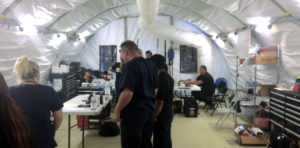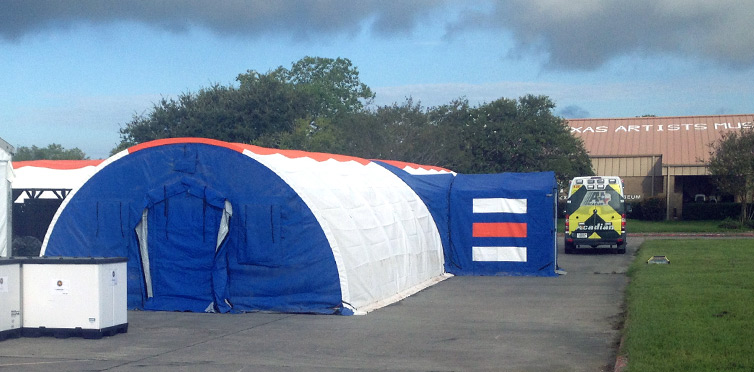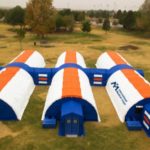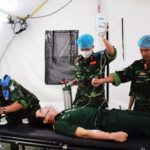BLU-MED Medical Facilities Deployed After Hurricane Harvey
The 2017 Atlantic Hurricane season, which officially ends November 30, has been record breaking, a test of human resolve and resiliency, and will require ongoing support for the massive recovery and rebuilding efforts.
Considered the most active hurricane season since 2005, this season could potentially also be the costliest – with an estimated $180 billion (USD) in damages, largely a result of the top three storms: Hurricane Harvey, Hurricane Irma, and Hurricane Maria. Records broken this hurricane season include the following:
- The formation of two Category 5 hurricanes (Irma and Maria) in a single hurricane season has only happened five other times.
- Hurricane Harvey was the first major hurricane to hit the southern United States since Hurricane Wilma in 2005, and broke the record for most rainfall from a single storm with accumulations of 64.58 inches.
- Hurricane Irma was the strongest hurricane, with maximum sustained winds of 185 mph to form in the Atlantic Ocean.
- Hurricane Maria’s landfall on Dominica, marked this hurricane season as the second on record since 2007, with two Category 5 hurricanes making landfall.
Add in the ‘apocalyptic’ devastation caused in Puerto Rico, after getting hit by Hurricanes Irma and Maria, the deadly Central Mexico earthquake, the wildfires in California, as well as the threat of nuclear, chemical or biological attacks from North Korea and a bleak picture starts to form.
Despite the despair and devastation caused during and after large scale natural disasters, they tend to bring out a resolute willingness to help others in need. Armed with social media and smart phones, volunteers from across the country arrived and “motored, rowed, and waded into dangerous waters to save family, friends and total strangers,” wrote The Washington Post. Working along-side Texas police, firefighters, the National Guard, the Coast Guard, government agencies, religious groups, and disaster relief organizations – the response to those impacted by Hurricane Harvey was unprecedented.
A month after Hurricane Harvey wreaked havoc across much of southern Texas and neighboring states, communities and individuals are still recovering and starting to rebuild. BCFS Health and Human Services (BCFS), an agency that provides disaster relief services and contracts with state and federal governments, is working with the Texas Department of Emergency Management and the Texas Commission on Health and Human Services to provide and operate temporary shelters for housing and medical facilities to the victims of Hurricane Harvey in two locations: Orange, Texas (in Orange County) and Port Arthur (in Jefferson County).
For each location, BCFS has setup 250 air-conditioned soft-walled shelters for temporary housing – capable of accommodating up to 14 people each. The shelters will act as a transition for people living in the affected areas while rebuilding their homes. Meals, shower and restroom facilities, as well as medical facilities and police staff will be available to residents.
The medical facility setup by BCFS in Port Arthur, Texas was an 18-bed BLU-MED mobile hospital purchased from BLU-MED Response Systems®. The 3-shelter medical facility was configured with 8-beds for a patient isolation (using BLU-MED’s negative pressure isolation system, designed to integrate seamlessly into their medical shelters) and 10-beds for providing advanced-level medical care. The BLU-MED medical facility provided a safe and clean space for medical care and was equipped with additional areas for reception, triage, administration workspaces, as well as a command and control.
 The second BLU-MED medical facility deployed in Orange, Texas by BCFS was a 2-shelter medical clinic designed for the same purpose.
The second BLU-MED medical facility deployed in Orange, Texas by BCFS was a 2-shelter medical clinic designed for the same purpose.
BLU-MED Response Systems®, a division of Alaska Structures, Inc., is The World’s Leader in Deployable Medical Facilities™. BLU-MED provides turnkey, portable shelter-based solutions for a wide range of applications including full service hospitals with alternate EOC, CBRNE, triage, isolation, immunization, decontamination, emergency rooms (ER), operating rooms (OR), intensive care units (ICU), burn unit, and mortuaries, mobile field hospitals, alternate command centers, temporary housing and base camp requirements for hospital expansion, surge capacity, and emergency disaster preparedness and response. BLU-MED also offers support services including a full range of medical equipment packages, vendor managed inventory, field deployment, and training & exercise support. For more information, visit: BLU-MED.


